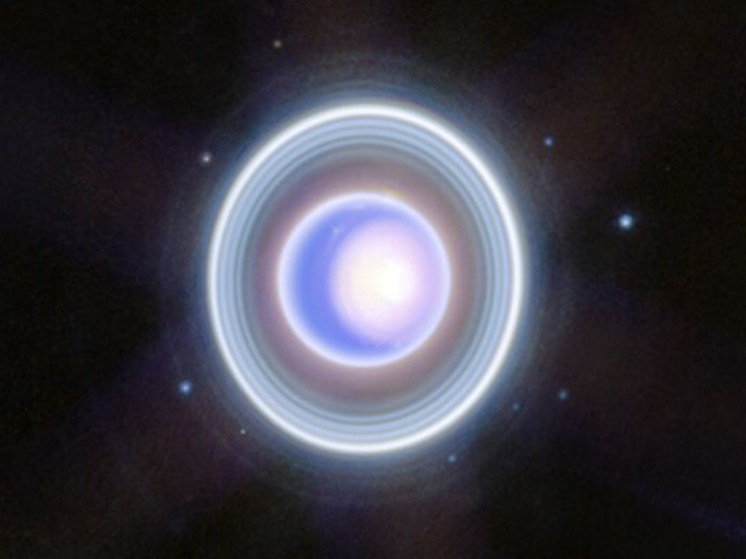Two reasons given to study Uranus closely
Astrophysicists are calling for international cooperation on the ambitious project amid growing interest in the mysterious planet. European space scientists have been asked to join forces with NASA to ensure the success of one of the most ambitious space missions planned for launch this century.

According to astrophysicists, robot participation in space flight to the mysterious planet Uranus would provide “the opportunity to participate in a pioneering flagship-class mission,” writes The Observer.
The leading scientific journal Nature published a special editorial calling on the European Space Agency (ESA) to establish an international partnership with NASA. Such cooperation would ensure that a mission to Uranus, which would involve placing a space robot in orbit around the planet and lowering a probe into its thick, icy atmosphere, would be completed on time and on budget.
Mission development it will take 10 years, and to reach Uranus after launch — 12-15 years, notes The Observer.
The editorial's authors, Aix-Marseille University astrophysics professor Olivier Mousis and American astrophysicist Robin Kanup of the Southwest Research Institute in Boulder, Colorado, said: “The lack of significant European participation in such a large-scale, perhaps once-in-a-lifetime mission will also undermine the large community of space scientists, engineers and technicians across Europe who have a keen interest in planets and the search for extraterrestrial life.”
The creation of a European-American partnership for the Uranus mission would not be unprecedented. In 2004, NASA's Cassini robotic spacecraft entered orbit around Saturn and then released the ESA-built Huygens probe, which then parachuted onto the planet Titan's moon, revealing a world with a crunchy, brittle surface and lakes of liquid hydrocarbons. The joint mission is considered a classic demonstration of the benefits of international cooperation in spaceflight.
In their editorial, Musis and Kanap argue that if ESA does not take the chance to join the Uranus mission, a consortium of individual European countries should be created to create probe, which will be launched from the main spacecraft built in the United States. The UK, which has a good track record of joint ventures in space, could well play a key role in such a venture.
Scientists say that Uranus has characteristics that give it special scientific significance. While the rest of the planets in our solar system spin like tops, Uranus lies on its side. And although it is not the most distant planet from the Sun, it is the coldest in the solar system, notes The Observer.
Uranus also has seasons of incredible length. Each pole is bathed in decades of uninterrupted sunlight, followed by decades of complete darkness. However, only one space probe has ever visited Uranus: in 1986, Voyager 2 flew past it, revealing a featureless, pale blue world with a family of moons.
Two years ago, the US National Academy of Sciences published a report saying which called for NASA to launch a probe to Uranus as a priority flagship mission. The academy's views have enormous influence, and this has forced NASA to launch a spacecraft to Uranus in the near future.
There are two key reasons for wanting to visit Uranus. The first is local. The solar system consists of three categories of planets: the inner rocky worlds of Mercury, Venus, Earth and Mars; two gas giants Jupiter and Saturn, which are farther from the Sun; and then, at the edge of the solar system, Uranus and Neptune. They are known as ice giants because their diameter is four times that of Earth, and their atmospheres contain large amounts of methane, water and other ice-forming molecules.
This last feature had always been considered intriguing, but not interesting enough to warrant a dedicated study until astronomers, armed with a variety of powerful new telescopes and space probes, began studying planets orbiting other stars.
To their surprise, they found that planets the size of Uranus and Neptune appear to be widespread in our galaxy. “Nature loves to create planets this size,” said Jonathan Fortney, a planetary scientist at the University of California, Santa Cruz, in an interview with Science magazine.
The question—and the second key reason for this mission—is why? Many theories have been put forward, but until Uranus is studied in detail, definitive answers will not be given. In addition to looking for evidence that could explain why ice giants are common around other stars, the mission's goal was also to explain why the planet is so cold and its spin axis is tilted sideways. Mausis and Kanap insist: “The scientific basis for a mission to Uranus is compelling.”


























































Свежие комментарии